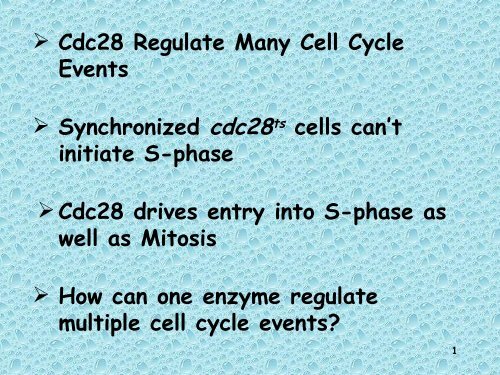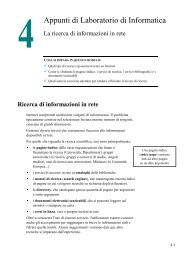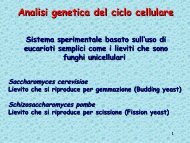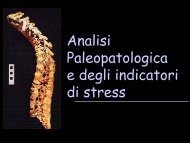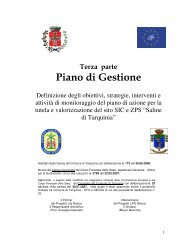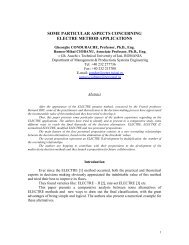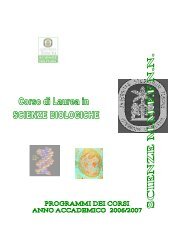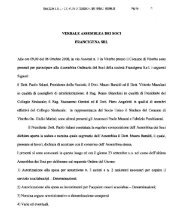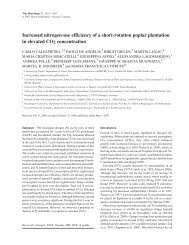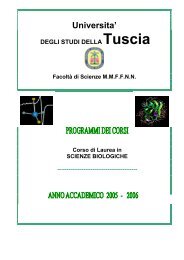RB - Università degli Studi della Tuscia
RB - Università degli Studi della Tuscia
RB - Università degli Studi della Tuscia
You also want an ePaper? Increase the reach of your titles
YUMPU automatically turns print PDFs into web optimized ePapers that Google loves.
Cdc28 Regulate Many Cell Cycle<br />
Events<br />
Synchronized cdc28 ts cells can’t<br />
initiate S-phase<br />
Cdc28 drives entry into S-phase as<br />
well as Mitosis<br />
How can one enzyme regulate<br />
multiple cell cycle events?<br />
1
Cells Use Multiple Cyclins to Regulate<br />
Different Cell Cycle Events<br />
Cicline M<br />
Cicline G1<br />
2
Il complesso MPF regola l’ingresso mitotico<br />
(studi su S. S. pombe) pombe<br />
Il complesso MPF è formato da<br />
Cdc28/cicline mitotiche in S. cerevisiae e<br />
Cdc2/Cdc13 in S. pombe<br />
Il complesso SPF regola l’ingresso in S<br />
(studi su S. S. cerevisiae)<br />
cerevisiae<br />
Il complesso SPF è formato da<br />
Cdc28/cicline G1 in S. cerevisiae<br />
3
Modello di azione del complesso Cdc28/cicline<br />
in S. S. cerevisiae<br />
4
Cyclin<br />
G1 Cyclins<br />
Cln1<br />
Cln2<br />
Cln3<br />
B-type Cyclins<br />
Clb1<br />
Clb2<br />
Clb3<br />
Clb4<br />
Clb5<br />
Clb6<br />
Budding Yeast Cyclin Genes<br />
Identification<br />
mutant<br />
mutant<br />
mutant<br />
Homology<br />
Homology<br />
Homology<br />
Homology<br />
Accidental<br />
Accidental<br />
Expression<br />
G1<br />
G1<br />
G1<br />
M<br />
M<br />
S<br />
S<br />
G1<br />
G1<br />
Function<br />
START<br />
START<br />
START<br />
Mitosis<br />
Mitosis<br />
Spindle<br />
Spindle<br />
S-phase entry<br />
S-phase entry<br />
5
Cyclins Nomenclature<br />
All contain “cyclin box” domain cdc2 binding domain<br />
Cyclin A<br />
Cyclin B’s<br />
S. pombe cdc13...<br />
S. cerevisiae CLB1,2,3,4,5,6<br />
G1 Cyclins<br />
S. cerevisiae CLN1,2,3<br />
A and B’s closely related<br />
- destruction box<br />
- required for S and M<br />
- “A” accumulates earlier,<br />
- degraded earlier<br />
- G1’s more similar to each other<br />
-PEST domains (Pro,Glu,SerThr)<br />
6
Cyclins can be grouped by expression patterns<br />
[Cyclin]<br />
- CLN1 and CLN2 and CLB5 and CLB6 -<br />
- CLB3 and CLB4<br />
- CLB 1 and CLB2<br />
CLN1,2,CLB5,6<br />
CLB3,4<br />
CLN3<br />
G1 Start Metaphase<br />
CLB1,2<br />
7
Yeast Cyclin Genes: CLNs and CLBs<br />
Clb3,4<br />
Activate replication<br />
origins<br />
Clb5,6<br />
G1 entry<br />
Triple cln1,2,3 mutant<br />
Quadruple clb1,2 mutant<br />
CLN1,2,3<br />
Sense cell size, commit to division<br />
Dominant CLN Mutations<br />
Clb1,2<br />
Spindle assembly<br />
anaphase
Vertebrate Cells, like budding yeast,<br />
express multiple cyclins, but they<br />
also express several CDK’s<br />
9
Regulation of G1/S transition (start/restriction point)<br />
Identification of mammalian G1 cyclins<br />
Human cDNA libraries screened for ability to complement CLN3 mutant<br />
lead to cloning of three human G1 cyclins:<br />
Cyclin C<br />
Cyclin D1<br />
Cyclin E<br />
Cyclin D2 and Cyclin D3 subsequently<br />
identified<br />
D-type cyclins: respond to growth factors<br />
G 0 to G1 transition<br />
E-type cyclin: expression is periodic<br />
peaks at G1/S transition<br />
controls ability of mammalian cells<br />
to enter S-phase<br />
10
Regulation of G1/S transition (start/restriction point)<br />
Identification of mammalian cyclin-dependent kinases (CDKs)<br />
Human cDNA libraries screened for ability to complement budding yeast<br />
CDC28 mutant<br />
Three cDNA clones identified which could complement CDC28 mutant<br />
Mammalian cdk1 acts at G2/M transition<br />
cdk2 acts at G1/S transition<br />
cdk3 unknown function<br />
Cdk4 identified in an anti-cyclin D coimmunoprecipitation<br />
experiment<br />
Unable to complement CDC28<br />
11
Punti di controllo del ciclo cellulare<br />
START PUNTO DI RESTRIZIONE<br />
Budding yeast Mammiferi<br />
13
Restriction point (START)<br />
Point at which cell is irreversibly<br />
committed to traversing the cell cycle<br />
Mammals: restriction point<br />
Yeast: START<br />
Cell cycle proceeds without influence<br />
from environment (only stopped by<br />
damage)<br />
Late in G 1<br />
14
To divide or not to divide:<br />
that is the question<br />
Yeast cells make decision based on<br />
cell size, which is dependent on<br />
nutrient availability<br />
Mammalian cells make decision based<br />
on the presence of protein growth<br />
factors called mitogens that<br />
stimulate cell growth<br />
15
In assenza di fattori di crescita le<br />
cellule di mammifero si arrestano in<br />
G0 (cellule cellule quiescenti);<br />
quiescenti<br />
L’aggiunta di mitogeni causa il<br />
passaggio attraverso il punto di<br />
restrizione (dopo dopo 14-16 ore); ore<br />
Le cellule in proliferazione entrano in<br />
S (dopo dopo altre 6-8 ore)<br />
ore<br />
16
Cyclin D is required to pass restriction point<br />
R point<br />
Colorazione 16 ore dopo la microiniezione<br />
e l’aggiunta di<br />
BrdU al mezzo.<br />
Colorante per DNA<br />
Anticorpi anti-BrdU<br />
Anticorpi anti-cicl.D<br />
17
Continous expression of Cyclin E shortens G1<br />
18
Attività dei complessi<br />
Cdk/ciclina dei mammiferi<br />
All’inizio <strong>della</strong> fase S le<br />
cicline D ed E vengono<br />
degradate. I livelli di Cdk4<br />
e 6 crollano repentinamente<br />
All’inizio <strong>della</strong> fase S viene<br />
sintetizzata la ciclina A che si<br />
associa a Cdk2. La distruzione <strong>della</strong><br />
ciclina A o una sua modificazione<br />
inibiscono la sintesi di DNA.<br />
Queste proteine non sono<br />
necessarie per la progressione<br />
nella fase S<br />
Il complesso Cdk2/ciclina A è<br />
indispensabile per la<br />
progressione nella fase S<br />
19
Cell-cycle phase-specific<br />
Three classes:<br />
G 1 Cdk complexes<br />
Cdk complexes<br />
S-phase Cdk complexes<br />
Mitotic Cdk complexes (also known as MPF)<br />
Cell-cycle phase specificity determined by<br />
cyclin type and, in some cells, Cdk type<br />
20
Controllo del ciclo cellulare dei mammiferi<br />
Ingresso in fase M (complesso MPF)<br />
Cdk1/ciclina A<br />
Cdk1/ciclina B<br />
Ingresso in fase S (complesso SPF)<br />
Cdk4,6/ciclina D punto di restrizione<br />
Cdk2/ciclina E<br />
Progressione in fase S<br />
Cdk2/ciclina A<br />
ingresso in S<br />
21
In addition to forming complexes between<br />
specific Cdks and their cyclin binding<br />
partners, all complexes require<br />
phosphorylation and dephosphorylation to<br />
become fully active<br />
phosphorylation of thr160/161 is<br />
important for the activation of all major<br />
Cdk/cyclin complexes<br />
catalysed by Cdk activating kinase CAK<br />
22
Regolazione <strong>della</strong> Cdk1 mediante<br />
fosforilazione-defosforilazione<br />
Siti di inattivazione<br />
Sito di attivazione<br />
Equilibrio tra fosfatasi (Cdc25) e kinasi (Wee1)<br />
23
Another mechanism by which<br />
CDKs can<br />
regulate Multiple Transitions<br />
is by using<br />
different CDK inhibitors<br />
(CKI’s)<br />
24
CDK activity is controlled by chemical modification,<br />
cyclin synthesis/proteolysis, and:<br />
CKIs (Cyclin-dependent kinase Inhibitors)<br />
25
CKI’s can be specific for particular CDK<br />
complexes because their binding can depend upon<br />
a specific cyclin<br />
CDK<br />
CKI<br />
T-Loop<br />
Cyclin<br />
26
Sic1<br />
Down-regulation of a CKI can, in turn, be<br />
regulated by a CDK-mediated phosphorylation<br />
because its ubiquitin-dependent proteolysis<br />
can be regulated by its phosphorylation state<br />
Cdc28/Cln1,2<br />
27
We can add another limb to our regulation tree<br />
Wee1 kinases<br />
Cdc25 phosphatases<br />
Kap1 phosphatases<br />
Phosphorylation<br />
Control<br />
Transcriptional<br />
Control<br />
Y15<br />
T160<br />
Ubiquitin-dependent<br />
Proteolytic Control<br />
Cdk-Activating<br />
Kinases (CAK)<br />
Cyclin-dependent Kinase<br />
Inhibitors (CKI’s)<br />
Transcriptional<br />
Control<br />
28
Inibitori delle Cdk<br />
Membri diversi di questa famiglia inibiscono Cdk diverse<br />
Inibitore cellule animali<br />
p15, p16<br />
p21, p27<br />
Inibitore lievito<br />
Far1<br />
P40<br />
Cyclin-Cdk complex<br />
Cdk4/ciclinaD<br />
Cdk6/ciclinaD<br />
Cdk4/ciclinaD<br />
Cdk6/ciclinaD<br />
Cdk2/ciclinaE<br />
Cdk2/ciclinaA<br />
Cdc2/Cln<br />
Cdc2/Clb<br />
29
Meccanismi di controllo dell’attività<br />
dei complessi ciclina/CDK<br />
Concentrazione delle cicline<br />
-livello di sintesi tramite controllo trascrizionale<br />
-proteolisi<br />
-localizzazione cellulare<br />
Fosforilazione delle CDK<br />
Inibitori delle CDK<br />
30
Situazioni biologiche in cui la proliferazione è controllata<br />
Embriogenesi: proliferazione attiva<br />
cicli cellulari brevi<br />
rapida successione di fasi di replicazione (S) e mitosi (M)<br />
crescita "logaritmica".<br />
Differenziamento: graduale attivazione di funzioni specializzate<br />
espansione clonale di cellule che si specializzano.<br />
contemporaneamente il ciclo di divisione viene modulato.<br />
Differenziamento terminale: arresto programmato del ciclo (GO).<br />
Reversibilità: cellule differenziate possono ripristinare il programma di<br />
divisione in risposta a stimoli (danni meccanici, agenti fisici etc.).<br />
Proliferazione neoplastica: innesco <strong>della</strong> proliferazione in assenza di<br />
programma, per mutazione di un gene cellulare o infezione di virus<br />
31
2 principali livelli di controllo <strong>della</strong> proliferazione di cellule eucariotiche:<br />
controllo <strong>della</strong> scelta tra destino proliferativo / entrata in quiescenza<br />
(G0) ed eventuale differenziamento <strong>della</strong> cellula.<br />
REGOLATO DALL’ ESTERN0<br />
controllo delle fasi del ciclo e coordinamento tra i diversi eventi necessari<br />
alla divisione cellulare.<br />
Controllo del ciclo cellulare e controllo <strong>della</strong><br />
proliferazione<br />
MECCANISMI DI CONTROLLO INTRINSECI<br />
32
Regulation of cell cycle<br />
A cell continues through the cell cycle after passing<br />
the restriction point (START START) unless it encounters<br />
genetic damage<br />
If the cell receives a go-ahead signal, it completes the<br />
cell cycle and divides otherwise it switches to a<br />
nondividing state, the G 0 phase. Most human cells are<br />
in this phase. Liver cells can be “called back” to the<br />
cell cycle by external cues (growth factors), but highly<br />
specialized nerve and muscle cells never divide.<br />
Progress though the cell cycle is monitored at four<br />
checkpoints<br />
33
Cell cycle checkpoints<br />
ensure integrity of the genome<br />
cell does not enter mitosis until DNA replication is<br />
complete and DNA damage is repaired<br />
ensure chromosome segregation does not occur if<br />
chromosomes are incorrectly aligned on the mitotic<br />
spindle and spindle formation is inhibited<br />
during the cell cycle a number of processes take<br />
place and they need to be co-ordinated<br />
each process involves synthesis, assembly and<br />
correct function; all the changes that take place<br />
during the cell cycle have to integrated and correctly<br />
regulated<br />
34
Checkpoint machinery<br />
Look out for defect<br />
and emit a signal<br />
Transmission of signals throughout<br />
the nucleus or cell and amplification<br />
SENSORS<br />
TRANSDUCERS<br />
Delay cell-cycle progression EFFECTORS<br />
35
Four checkpoints<br />
36
THE G1/S CHECKPOINT<br />
37
GROWTH FACTORS ARE INVOLVED<br />
IN PASSING THE G1 CHECKPOINT<br />
1. Arrival of<br />
growth factors<br />
from other cells.<br />
Cyclin<br />
Cyclin<br />
Cyclin<br />
Cyclin<br />
2. Growth factors<br />
cause increase in<br />
cyclin concentration.<br />
CdK<br />
CdK<br />
Cyclin<br />
Cyclin<br />
3. Cyclin activates<br />
cyclin-dependent<br />
kinase.<br />
ATP<br />
ADP<br />
CdK<br />
P i<br />
Cyclin<br />
Target<br />
protein<br />
4. Kinases activate S<br />
phase proteins, leading<br />
to cell division.<br />
38
Growth factor signalling and<br />
transcription<br />
Growth factors increase the expression of specific<br />
genes:<br />
1. early response genes:<br />
rapid increase in mRNA and protein levels<br />
include transcription factors such as E2F, c-myc, cfos,<br />
c-jun<br />
2. delayed response genes:<br />
include cell cycle proteins such as Cdks, cyclins<br />
expression regulated by early response genes<br />
39
Regulated expression of two classes of<br />
genes returns G0 G mammalian cells to<br />
the cell cycle<br />
Early-response<br />
genes:<br />
Transcription factors<br />
(E2F)<br />
Delayed-response<br />
genes:<br />
CyclinD, E<br />
Cdk2, 4, 6<br />
40
Il passagggio attraverso il punto di<br />
restrizione dipende dalla attivazione di<br />
fattori di trascrizione E2F<br />
I fattori E2F attivi stimolano la propria<br />
sintesi e quella <strong>della</strong> Cdk2 e <strong>della</strong> Ciclina E;<br />
Il complesso Cdk2/CyclE porta all’aumento di<br />
fattori E2F attivi<br />
41
E2F is a transcription factor that by itself<br />
activates transcription<br />
E2F<br />
However, Rb binds to E2F and represses its<br />
activation function<br />
Rb<br />
gene expression<br />
42
P<br />
P P<br />
Rb<br />
E2F<br />
P<br />
Rb repression is regulated by<br />
early G 1 Cyclins-CDKs<br />
S-phase gene transcription<br />
When Rb repression is inhibited by phosphorylation of Rb by<br />
early G 1 Cyclin-CDK protein kinases (Cyclin D-CDK4/6), E2F<br />
stimulates the expression of genes required for S-phase,<br />
including genes encoding DNA polymerases and other proteins<br />
required for DNA synthesis, enzymes that synthesize<br />
dNTPs, and genes encoding late G 1 Cyclin-CDKs (Cyclin E and<br />
CDK2) and the major S-phase Cyclin (Cyclin A).<br />
43
The G1/S transition in human cells: Rb (retinoblastoma<br />
protein) regulates E2F proteins, which are transcription<br />
factors for S phase genes<br />
44
Tumor-suppressor genes<br />
Genes capable of suppressing the tumorforming<br />
potential of transformed cells<br />
Tumor suppressor genes normally function<br />
to suppress cell growth and division.<br />
Tumor-suppressor genes encode :<br />
Regulatory proteins eg rb, rb p53<br />
Intra-cellular signaling proteins (nf1-<br />
Neurofibrosarcomas)<br />
Cell adhesion proteins (dcc–colon carcinomas)<br />
45
Tumor-suppressor genes<br />
Cells become malignant by losing tumor<br />
suppressor gene activity.<br />
These act as Mendelian recessive traits.<br />
A cell has to be homozygous for a<br />
nonfunctional (or missing) tumor<br />
suppressor gene for it to have an effect.<br />
Analogy<br />
Tumor suppressor brake pedal<br />
Lack of suppressor no brake pedal<br />
46
Gene oncosoppressore Rb<br />
• Raro tumore dell’occhio che<br />
colpisce circa un bambino<br />
su 14000 nati<br />
• Provocato da due mutazioni<br />
consecutive che<br />
interessano entrambe le<br />
copie del gene Rb<br />
47
What is the defect in hereditary retinoblastoma?<br />
Rb Rb<br />
Normal person:<br />
2 good copies of<br />
Rb gene<br />
Compromise this good one, then problems!<br />
or<br />
Rb<br />
Hereditary retinoblastoma<br />
patient: 1 good copy of<br />
Rb gene, 1 defective copy<br />
48
Il retinoblastoma erediatrio viene ereditato<br />
come carattere autosomico dominante<br />
Poiché il gene Rb è localizzato sul cromosoma 13<br />
sia i maschi che le femmine hanno la stessa<br />
predisposizione alla malattia<br />
49
Perdita dell’eterozigosi <strong>degli</strong> antioncogeni<br />
50
Meccanismi genetici alla base del<br />
retinoblastoma<br />
51
Retinoblastoma and the “Two-hit”<br />
model of carcinogenesis<br />
Knudsons “two-hit” hypothesis:<br />
familial cases (high frequency, early onset):<br />
retinoblastoma caused by a germline mutation of<br />
one Rb allele + an acquired somatic mutation of<br />
the remaining allele of the Rb gene = both<br />
inactivated<br />
sporadic cases (low frequency, late onset):<br />
retinoblastom caused by two acquired somatic<br />
mutations in both alleles = both inactivated<br />
52
Knudson’s 2-hit mutation model for retinoblastoma<br />
53
<strong>RB</strong> = tumor suppressor gene<br />
<strong>RB</strong> was the first tumor<br />
suppressor to be<br />
identified.<br />
<strong>RB</strong> is absent or mutated<br />
in at least one-third of<br />
all human tumors.<br />
Cloning of the retinoblastoma gene<br />
mapped to 13q14 (loss of heterozygosity)<br />
rb-1 gene cloned 1986-87<br />
Mutated or lost in all cases of retinoblastomas<br />
Also found mutated in osteosarcoma and small-cell lung cancer<br />
54
Il gene Rb-1<br />
Genetica<br />
Frequenza del tumore: 1/14.000 nascite<br />
Le cellule tumorali sono prive di entrambi gli alleli Rb-1 funzionali<br />
Assetto più frequente: una piccola delezione trasmessa dalla linea germinale, poi<br />
una mutazione di senso sull’allele omologo dà origine a un clone somatico<br />
Associazione di molti casi di tumore con la delezione <strong>della</strong> banda 13q1.4<br />
Trasmissione mendeliana semplice:<br />
predisposizione allo sviluppo di tumori dominante: un cromosoma "difettivo"<br />
predispone tutti i portatori a sviluppare tumori;<br />
sviluppo di tumori recessivo: il tumore si sviluppa in completa assenza del<br />
prodotto, quando entrambi gli alleli sono deleti e/o mutati<br />
<strong>Studi</strong> in sistemi modello<br />
trasfezione del gene Rb1 in cellule proliferanti,<br />
microiniezione di proteina pRb,<br />
inibiscono il superamento <strong>della</strong> transizioneG1/S<br />
Topo Rb-/- : letale (difetti nell’eritropoiesi e nei tessuti neuronali)<br />
55
<strong>RB</strong> - structure of gene and protein<br />
Gene<br />
– Highly complex: 200 kb with 27 exons and introns from<br />
80bp to 60kb<br />
Protein<br />
– multiple bands Mw= 110-116 kDa<br />
– nuclear phosphoprotein<br />
– binds DNA non-specifically<br />
Rb contains several functional domains<br />
– Domains A and B are highly conserved from humans to<br />
plants, and they interact with each other along an<br />
extended interdomain interface to form the central<br />
“pocket”, which is critical to the tumour suppressor<br />
function of Rb<br />
56
Caratteristiche strutturali di Rb<br />
La proteina Rb può essere suddivisa in quattro domini. Il dominio N<br />
è responsabile dell’oligomerizzazione <strong>della</strong> proteina in vitro. I<br />
domini A e B, detti “A/B pocket”, sono responsabili del legame di<br />
Rb a vari fattori trascrizionali, come E2F e varie oncoproteine<br />
virali, e risultano spesso mutati in vari tumori. Il quarto dominio,<br />
detto “C pocket” è un sito di legame per c-Abl .<br />
57
<strong>RB</strong> FAMILY<br />
p105 <strong>RB</strong>; p107; p130<br />
p<strong>RB</strong> binds to the transcriptional activation<br />
domain of E2F and blocks activation<br />
E2Fs transactivate expression of genes<br />
that are important for S phase:<br />
dihydrofolate dihydrofolate reductase<br />
thymidine thymidine kinase<br />
polymerase<br />
polymerase <br />
histones histones<br />
58
<strong>RB</strong>´s function: “a signal transducer<br />
connecting the cell cycle clock with the<br />
transcriptional machinery”<br />
Cell cycle clock<br />
G2<br />
S<br />
M<br />
G1<br />
Rb<br />
Transcriptional apparatus<br />
<strong>RB</strong> constitutively expressed and relatively stable<br />
half-life ≥ 12 hours<br />
Still induced increase in levels<br />
resting G0 cells + mitogenic stimuli = <strong>RB</strong> level increased 4-6x<br />
<strong>RB</strong> modified by phosphorylation during cell cycle<br />
59
G0<br />
CycC-Cdk3<br />
pRb<br />
Rb a substrate of<br />
CycD-CDK<br />
CycE-CDK<br />
CycA-CDK<br />
60
<strong>RB</strong> is active only within a limited time<br />
window during the cell cycle<br />
Before the R-point in G1:<br />
Rb hypophosphorylated = active repressor<br />
of growth (inhibits cell cycle progression)<br />
SDS-PAGE: 110 kDa<br />
After the R-point in G1:<br />
Rb hyperphosphorylated = inactive<br />
repressor of growth (facilitates cell cycle<br />
progression)<br />
SDS-PAGE: 112 - 116 kDa<br />
Rb is dephosphorylated at the<br />
end of mitosis<br />
G2<br />
S<br />
M<br />
G1<br />
active<br />
repressor<br />
Rb<br />
Rb<br />
R<br />
P P P PPP<br />
Inactive<br />
repressor<br />
61<br />
P
Gate-keeper model for <strong>RB</strong><br />
The R-point functions as a door that is kept closed by Rb<br />
G1 arrest upon overexpression of Rb<br />
Under conditions favourable for proliferation ⇒ Rb phosphorylated<br />
⇒ R-door is opened<br />
In cells with lost Rb-function the door is left open all the time<br />
Such cells will also have lost the ability to respond to growthpromoting/-inhibitory<br />
signals<br />
Mitogenes (+), TGFβ (-), contact-inhibition (-)<br />
Two key elements in this model:<br />
upstream signals ⇒ Rb´s phosphorylation status<br />
Rb´s phosphorylations status ⇒ downstream effects<br />
Rb as “signal transducer”<br />
Cell cycle-clock ⇒ <strong>RB</strong>´s phosphorylation status<br />
<strong>RB</strong>´s phosphorylation status ⇒ transcription apparatus involved<br />
in proliferation<br />
62
G2<br />
P<br />
P<br />
S<br />
P<br />
M<br />
Gate keeper model<br />
G1<br />
P<br />
P<br />
R<br />
P<br />
P<br />
Cdk4/6<br />
Cyclin D<br />
Rb<br />
E2F released<br />
S-phase genes expressed<br />
63
E2F liberated by Rb inactivation<br />
• Rb excert its effects through E2F TFs<br />
Rb = active repressor<br />
R-point<br />
Rb = inactivated<br />
E2F = activated!<br />
64
<strong>RB</strong>´s phosphorylation status<br />
⇒ a signal to the transcription apparatus<br />
• Hypophosphorylated <strong>RB</strong> binds and<br />
inactivates the transcription factor<br />
E2F/DP<br />
• Hyperphosphorylation of <strong>RB</strong> ➨ E2F/DP<br />
liberated and free to activate genes<br />
necessary for proliferation<br />
65
E2F/DP<br />
dimers<br />
The functional state of the retinoblastoma protein<br />
(pRb) controls cell proliferation<br />
pRb<br />
GFs, mitogens...<br />
cyclin D1<br />
synthesis<br />
5’..TTTCCGCG…3’<br />
wt pRb represses transcription of cell cycle genes<br />
Cell cycle genes off<br />
G0<br />
cyclin D1<br />
cdk4/6<br />
Active cyclin/kinase<br />
complex<br />
Phosho-pRb becomes inactive<br />
P<br />
Cell cycle progression<br />
G1<br />
P<br />
RNA pol<br />
II<br />
5’..TTTCCGCG…3’<br />
66
Target genes controlled by<br />
activating E2Fs<br />
E2F sites<br />
common consensus binding site: TTTCGCGC<br />
No difference in sequence preference between different<br />
E2Fs<br />
target genes: E2F controls the transcription of cellular genes<br />
that are essential for cell division:<br />
cell cycle regulators<br />
such as cyclin E, cyclin A, Cdc2, Cdc25A, <strong>RB</strong> and E2F1,<br />
enzymes that are involved in nucleotide biosynthesis<br />
such as dihydrofolate reductase, thymidylate synthetase<br />
and thymidine kinase<br />
67
E2F/DP only active in a window<br />
of the cell cycle (late G1 ➜ early S)<br />
• Early G1: active <strong>RB</strong> ➜ E2F/DP turned OFF<br />
• The R-point: inactivated <strong>RB</strong> ➜ E2F/DP turned ON<br />
– E2F/DP liberated ➜ activation of E2F-dependent<br />
promoters<br />
• Late S: E2F/DP turned OFF again<br />
– cyclin A/cdk2 ➜ phosphorylation of E2F/DP ➜ reduced<br />
DNA-binding ➜ target genes turned off<br />
68
HOW ARE S PHASE PROTEINS ACTIVATED?<br />
Rb<br />
E2F<br />
1. In normal cells,<br />
Rb protein binds<br />
to E2F and shuts<br />
down the cell cycle.<br />
ATP<br />
ADP<br />
CdK<br />
P i<br />
Cyclin<br />
Rb<br />
E2F<br />
2. If growth factors arrive and<br />
activate the cyclin-CdK<br />
complex, Rb becomes<br />
phosphorylated.<br />
P i<br />
Rb<br />
E2F<br />
3. E2F is<br />
released<br />
E2F<br />
S Phase<br />
proteins<br />
mRNA<br />
DNA<br />
4. E2F stimulates the<br />
production of S phase<br />
proteins.<br />
When Rb is mutated, no “tie-up” of E2F, so constant S phase turn on<br />
69
Effetti delle mutazioni del Gene Rb<br />
Osteosarcomi<br />
Carcinomi:<br />
1) Polmonari<br />
2) Mammari<br />
3) Prostatici<br />
70


